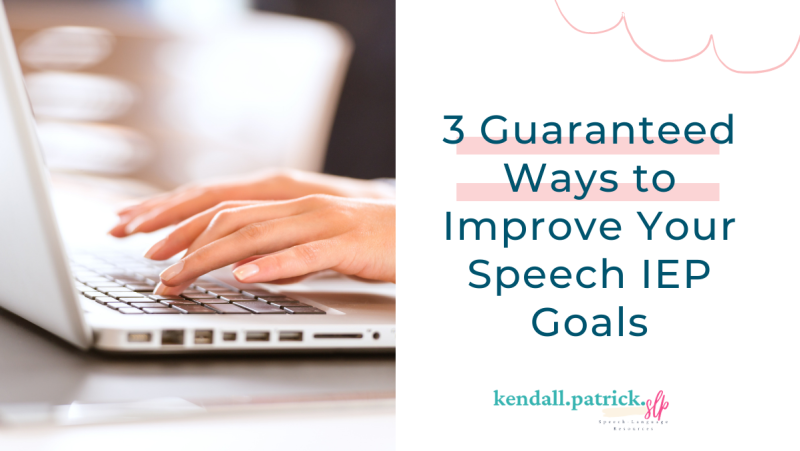Speech IEP goals can be tricky at times, but I’m here to share my best goal-writing and implementation tips. I find it easiest to have a few good core goals ready to go. Then I can then individualize depending on the student and their needs. Keeping a steady log of these goals makes IEP goal writing so much easier.
To gain access to my IEP goal bank and some of my other favorite freebies, sign up below!
How to Write IEP Goals
One thing I struggled with the most when I was starting out my first year was quickly and easily writing IEP goals. Whether they were new IEP goals or updating old goals for students on my caseload. I tended to overthink and write and rewrite my goals until they were just right. This made it really hard on me. For more on my journey as a school SLP, click here.
Now 10 years in, I have created an IEP goal bank for myself. This bank includes ideas (in my head and on paper) that are my go-to starting points when writing an IEP. These basic goals give me a good starting point when writing my IEPs. Then all I have to do is go in and individualize based on that student’s needs. Now, is absolutely everything included here? No. Will there always be outliers or students with totally different needs? Absolutely. After all, this is the schools and we just never know what each year will bring. However, we can be pretty sure we’ll need a couple of key goals in the main areas we see each year. For me, that would be Arctic, Vocabulary, Organization, Fluency, and Comprehension.
SMART Goals
Smart goals are goals that are written to be specific, measurable, attainable, relevant and time-based. Let’s break some of these down.
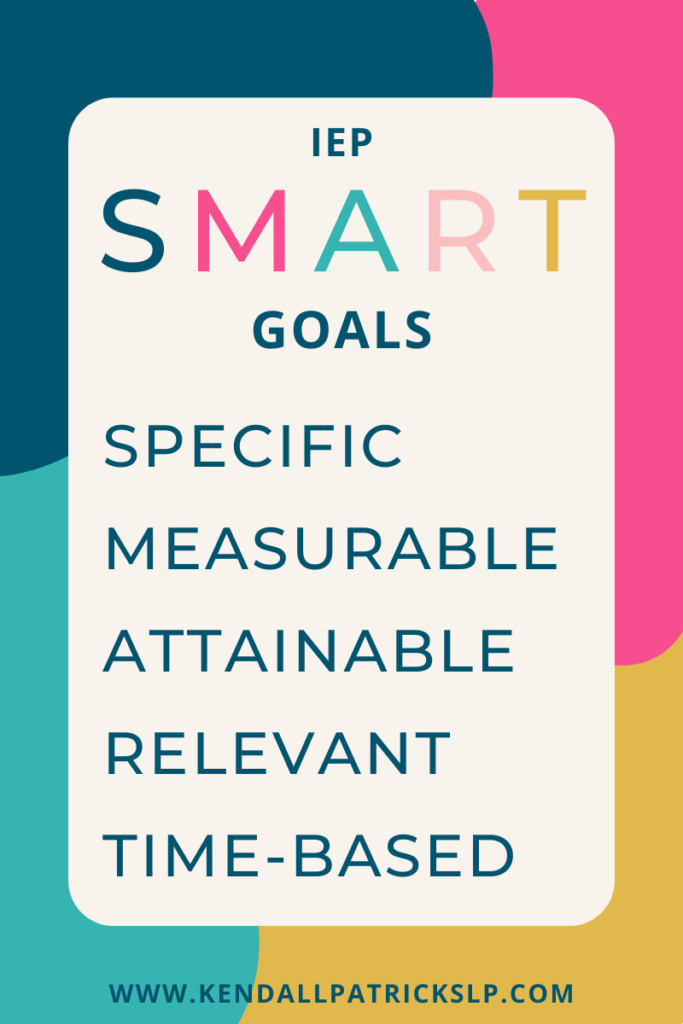
Specific – your IEP goals should be specific and define exactly what you were wanting to be accomplished. They should also specify who will accomplish it and what steps will be taken to accomplish it.
Measurable – your IEP goal should be measurable so that you can track progress. You should easily be able to tell when they are mastered.
Attainable – your IEP goal should be attainable. This means it’s a goal that the student can meet within a reasonable amount of time. This is typically within the school year or one calendar year. And remember it should be specific to the student. So if that student’s accuracy is currently at 0% an attainable goal for them may be 50 to 60%, not 80.
Relevant – your IEP goal should be related to the big picture. Ask yourself what you are trying to accomplish or what you want the student to accomplish with this goal. Whether it’s gaining access to grade-level material in the classroom or building the foundational skills they need in order to gain those age-appropriate skills. Make sure it is relevant to that student’s specific means, not just based on a norm-referenced test item.
Time-based – last but not least make sure your IEP goal is time-based. Have a date and time in which the goal is expected to be mastered. This may be by the end of the school year, by the next grade level, or the IEP expiration date.
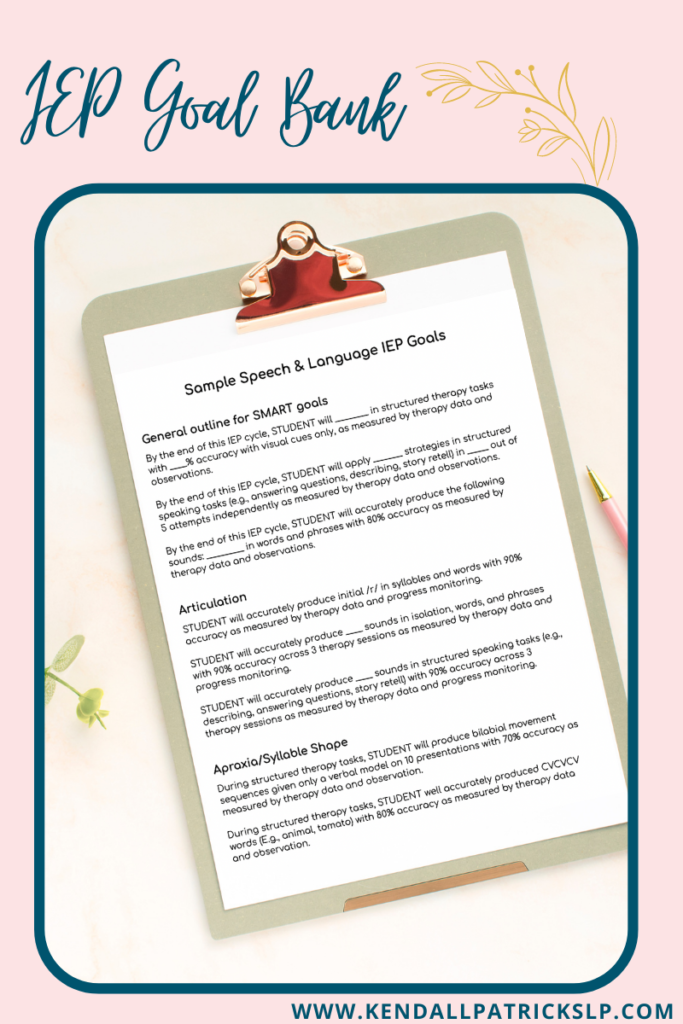
Sample Speech IEP Goals
Below are some example SMART IEP goals that I may write for my students working on articulation, language, or fluency.
- By the end of this IEP cycle, STUDENT will ________ in structured therapy tasks with ____% accuracy with visual cues only, as measured by therapy data and observations.
- By the end of this IEP cycle, STUDENT will apply _______ strategies in structured speaking tasks (e.g., answering questions, describing, story retell) in _____ out of 5 attempts independently as measured by therapy data and observations.
- By the end of this IEP cycle, STUDENT will accurately produce the following sounds: _________ in words and phrases with 80% accuracy as measured by therapy data and observations.
Speech IEP Goals Bank
A speech IEP goals bank is a great place to start when writing a new IEP. This is especially true when you are new to the schools. While absolutely IEP goals fro speech should always be individualized, it doesn’t hurt to have a place to start. My IEP goals bank is a brief, but inclusive list of a variety of goals. These goals target various areas of speech and language therapy.
IEP Goals Bank
My IEP goals bank includes goals for various areas of communication including articulation, fluency, apraxia, phonological awareness, vocabulary, grammar, and story retell.

Flexibility in Goal Writing
Remember, while it is great to have a goal bank in a place to start, you always have to individualize. What is right for one student may not necessarily be what’s right for another. Even when students are working on similar goals they may reach those goals in different ways and at different times. This is where you can individualize percentages, number and types of prompts needed/provided, in what situations, and with what mode of communication.
IEP Goals for Communication
A lot of us write and work on “wh” question goals in therapy quite frequently. One mistake I see a lot when reading these goals is that they are too open-ended and not specific enough. There are so many different types of “wh” questions as well as ways to teach them. I like to initially write my goals to work on one or two types (e.g., “who” and “what” as they are earlier to develop) in the context of a thematic unit. So specifically teaching types of answers to who and what questions and the vocabulary needed.
Then I move on to where, when, why, and how – as these are more complex and can have different types of answers as well. For example, “where” answers can be specific locations (e.g., Florida, grocery store) or prepositional phrases (e.g., under the chair). How questions are typically the most complex and include other needed language skills as well such as describing (e.g., “How does it feel?”) or sequencing (e.g., “How do you build a snowman?”).
Here is an example of a basic “wh” question goal:
- During structured therapy tasks, STUDENT will answer “who” and “what” questions related to a thematic unit with 80% accuracy as measured by therapy data and observations.
Another way I work on and write goals for “wh” questions is in relation to an orally read story. I typically work on these skills within a unit to address story narrative goals as well.
Here are some examples of these types of “wh” questions and a general retell goal:
- During structured therapy tasks, STUDENT will answer “where” and “when” questions related to an orally presented story with 80% accuracy as measured by therapy data and observations.
- STUDENT will apply an organizational strategy to express 3-4 story grammar parts (e.g., character, setting, problem, ending) following an orally presented story in 3 out of 4 attempts as measured by therapy data and progress monitoring.
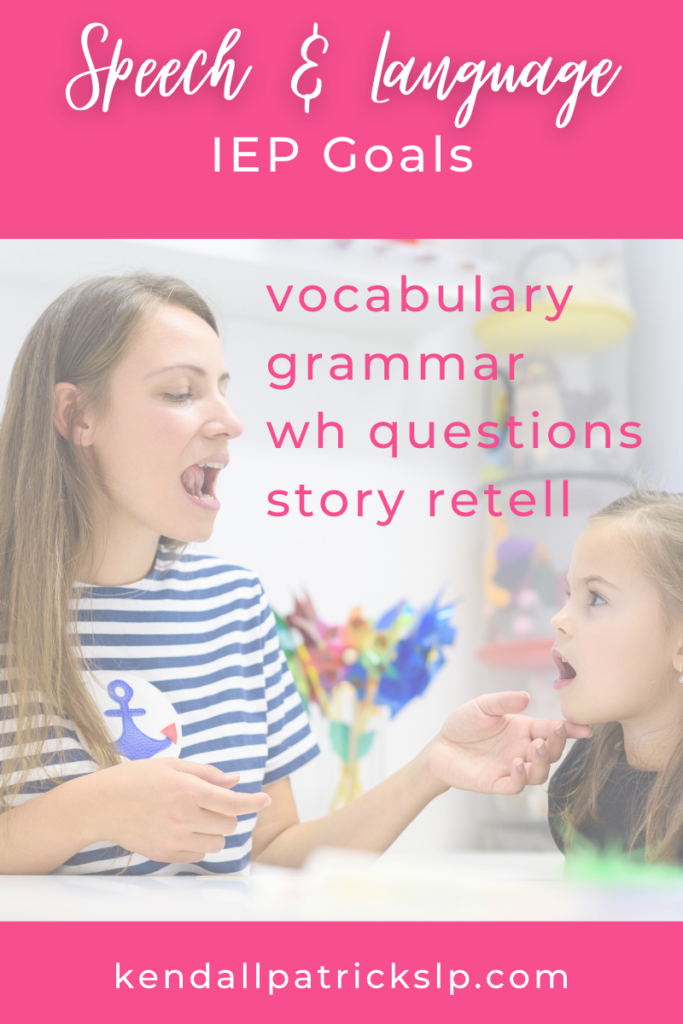
Apraxia of Speech IEP Goals
When working with students to have apraxia, I write my goals a little bit differently. Instead of focusing on specific sounds that I want the student to produce correctly, I might focus on placement and movement between placement at different syllable levels. Here are a couple of examples of how I might ride my apraxia goals:
- During structured therapy tasks, STUDENT will produce bilabial movement sequences given only a verbal model on 10 presentations with 70% accuracy as measured by therapy data and observation.
- During structured therapy tasks, STUDENT well accurately produced CVCVCV words (E.g., animal, tomato) with 80% accuracy as measured by therapy data and observation.
- During structured therapy tasks, STUDENT will accurately produce words with contrasting sound pairs (e.g., D/K, D/G, T/K, T/G with 80% accuracy as measured by therapy data and observation.
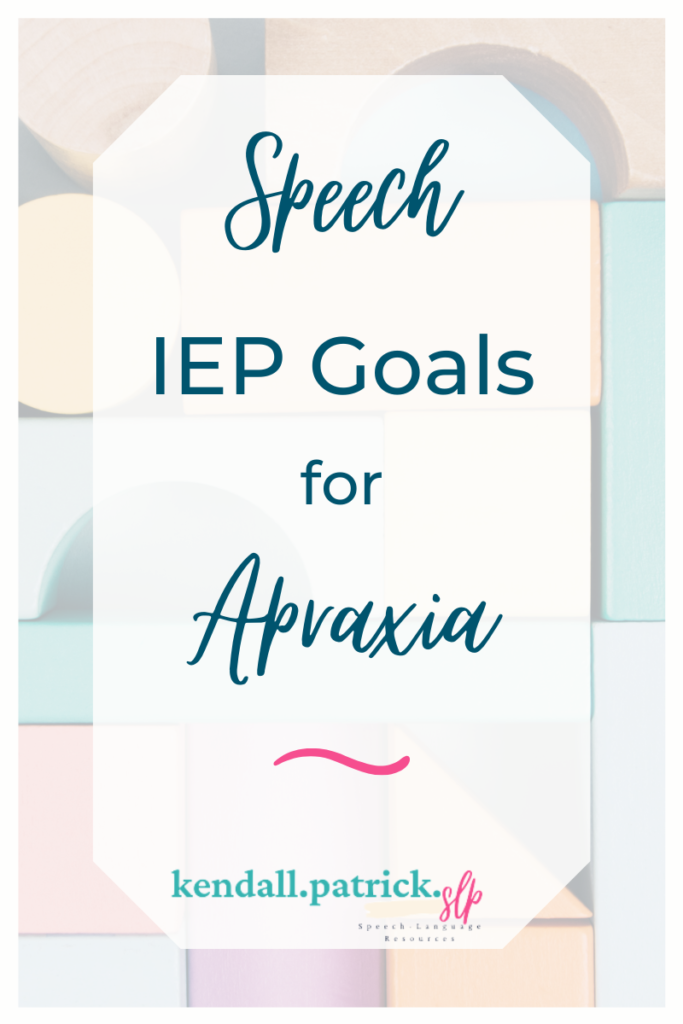
Fluency IEP Goals
When writing fluency goals, I like to focus on the use of implementation of fluency strategies versus focusing on reducing the number of disfluencies in speech. I like to rate levels of success and mastery based on my students’ confidence in their speech and their ability to apply strategies on their own versus how many disfluencies they are actually producing. I would rather my student have a higher level dysfluencies, but be able to apply strategies when needed (and with confidence) rather than a student with less disfluencies, who is also less confident in their speech and/or unable to apply strategies independently.
Here are some of my example fluency goals:
- During structured therapy tasks, STUDENT will use fluency strategies (e.g., smooth speech, slow rate, full breath, etc.) and structured speaking tasks (e.g., answering questions, story retail, therapy games), with the use of visual cues and reminders, in four out of five opportunities.
- STUDENT will self-monitor his use of fluency strategies using an SLP-created rating scale in four out of five opportunities as measured by therapy data and observations.
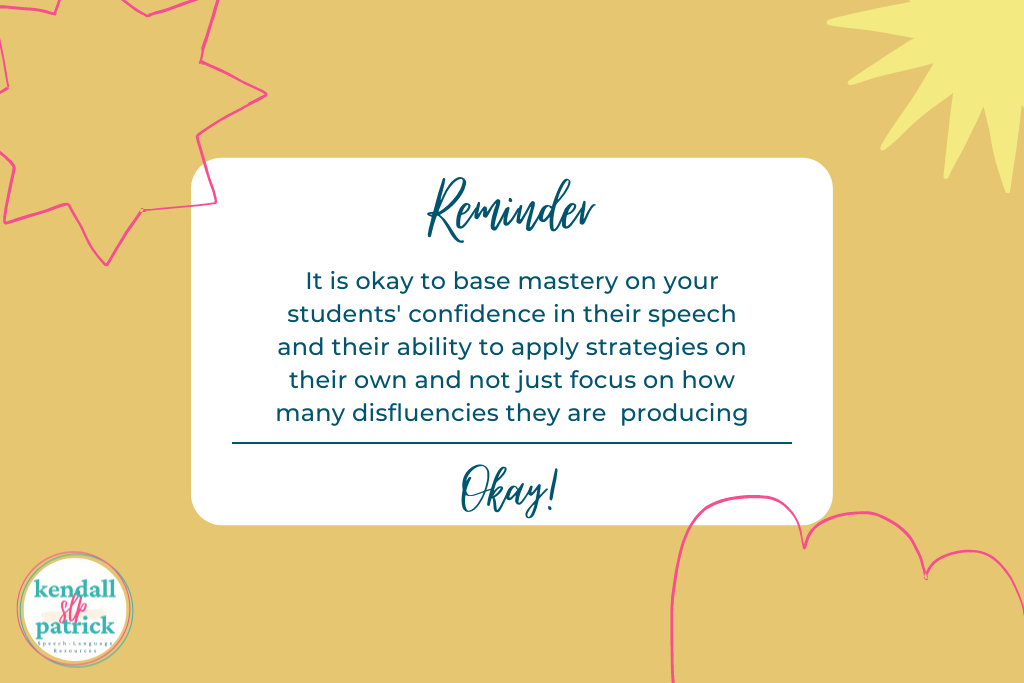
Phonemic Awareness IEP Goals
When writing phonemic awareness goals to incorporate in therapy, I include the tasks in developmental order. I work in the hierarchy until each level is mastered. Here is an example of a goal I might write for a kid who is moving past syllable level and into the phoneme level.
- During structured therapy tasks, STUDENT will complete the following phonological awareness tasks: syllable deletion, phoneme isolation, phoning blending, phoneme segmentation, and phoneme deletion with 80% accuracy as measured by therapy data and observations.
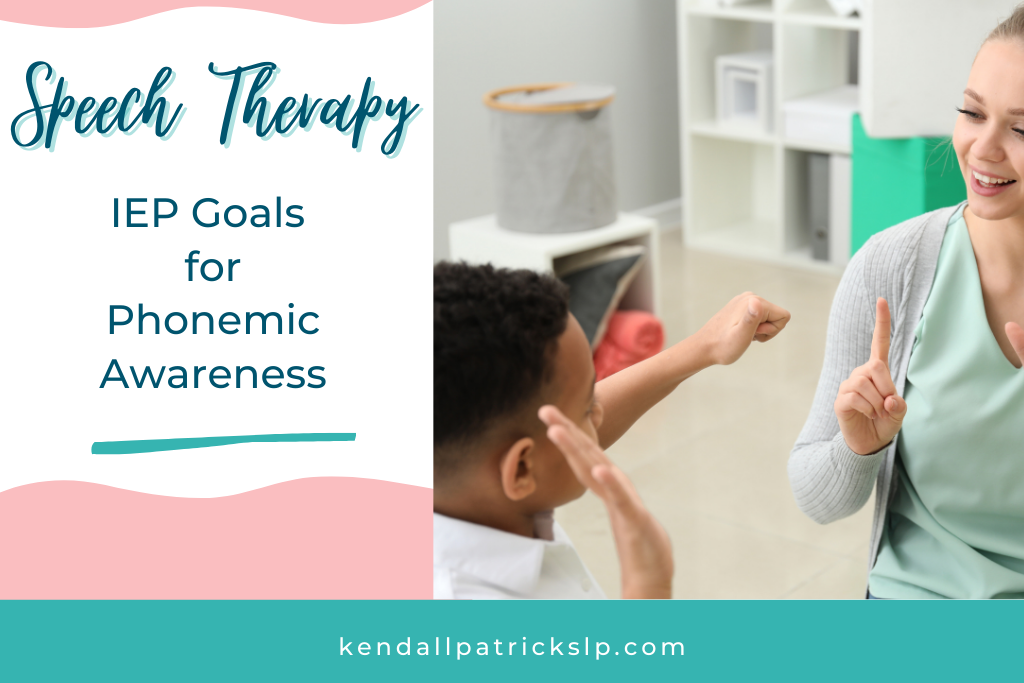
IEP Goals for Vocabulary
When writing vocabulary goals, I like to focus on the implementation and use of strategies. Not just focusing on learning new vocabulary words. I feel it is more important that the students we work with learn strategies that they can apply to any material and any new vocabulary word. Instead of just memorizing words that they’ll probably forget later on.
Here is an example of how I write some of my goals:
- During structured therapy tasks, STUDENT will apply an organizational strategy to provide 3 to 4 details when defining/describing presented vocabulary as measured by therapy data, student product, and/or progress monitoring.

More Speech IEP Goal Tips:
Speech Therapy Goals from Bilinguistics
5 Tips to Write Speech Goals for IEPs from SLP Now
5 IEP Goals for Preschool Speech Therapy from Simply Special Ed
Don’t forget to sign up with your email address here to get access to my free library (growing monthly). It is full of some of my favorite goodies made exclusively for my followers.
I hope you found some of these ideas helpful and can use one or more in your therapy room. Please leave a comment or shoot me an email if you want to share some of your go-to speech IEP goals.

